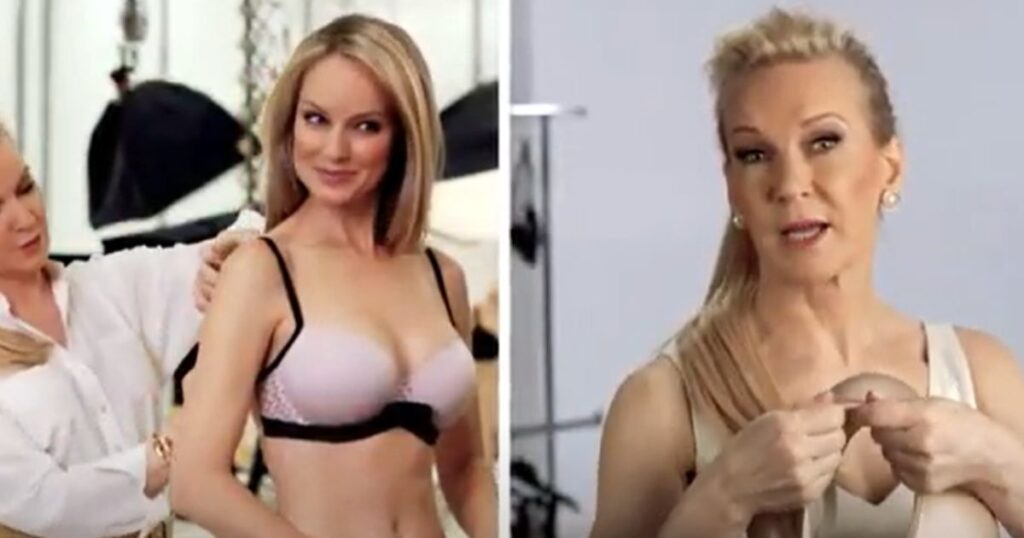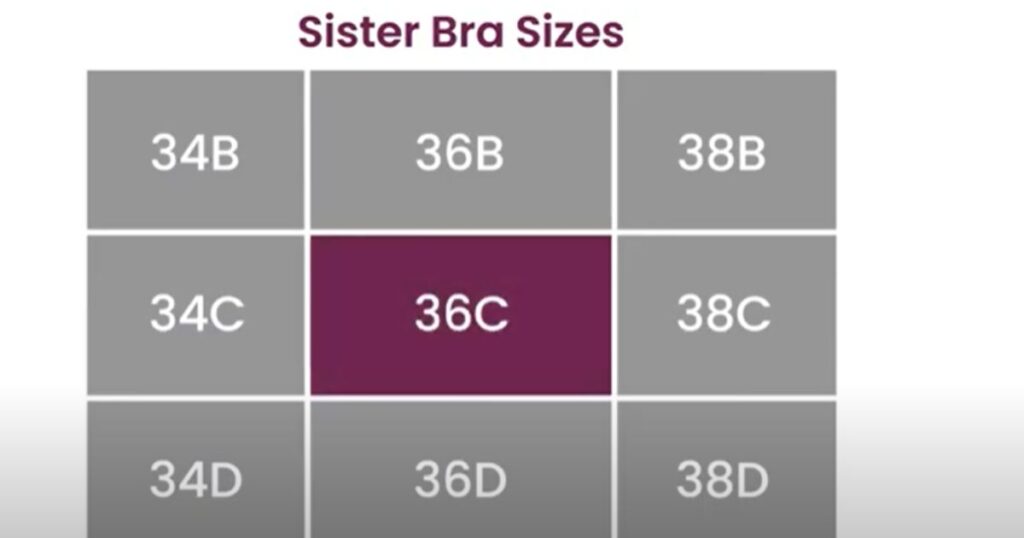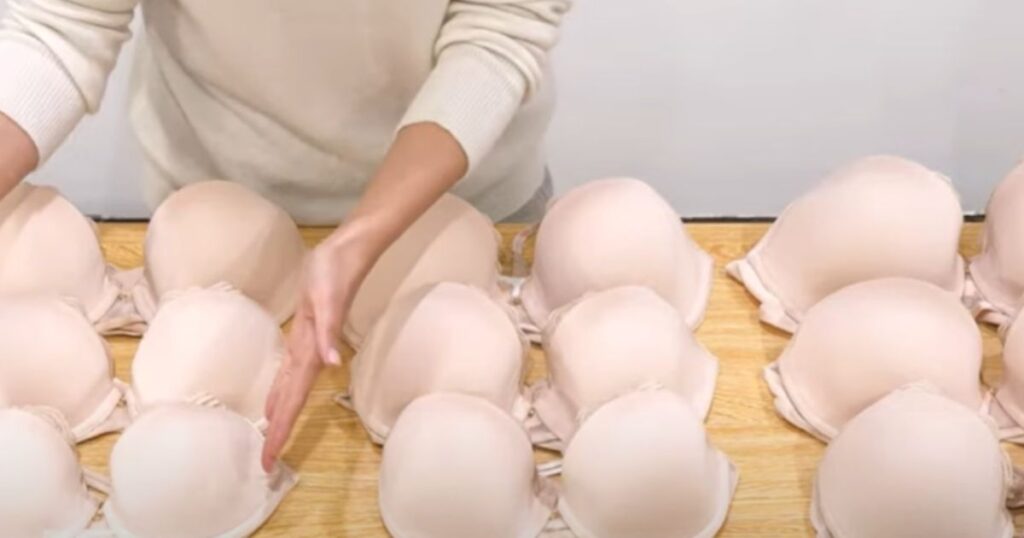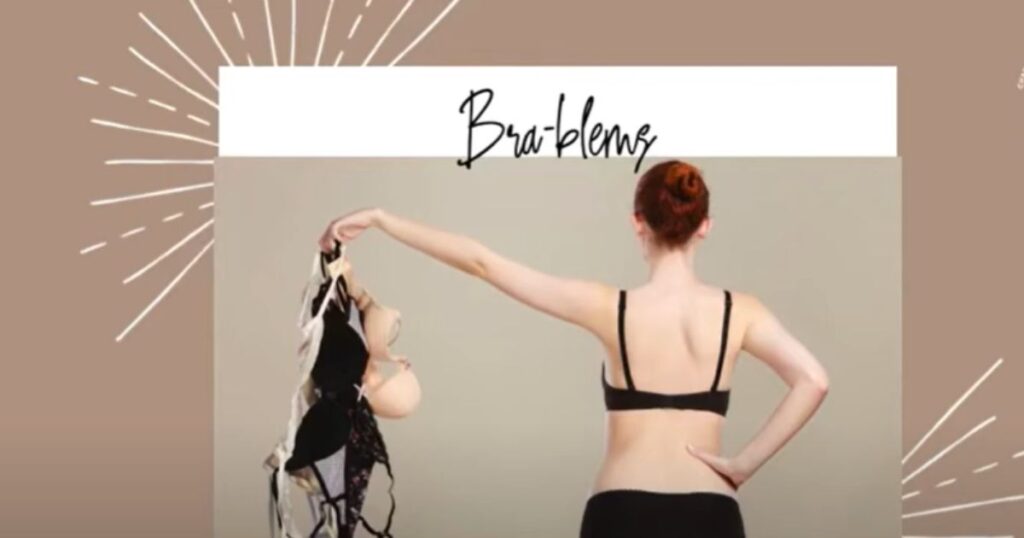As an Amazon Associate, I earn from qualifying purchases
Bra sister sizes are alternate sizes where the cup volume stays the same even though the band size changes. To find a sister size, you either go up in band size and down in cup size or vice versa
Understanding bra sister sizes can be a game-changer for women struggling to find the perfect fit. Sister sizes are not a new concept in the world of lingerie, yet many shoppers overlook their importance. A well-fitted bra can enhance posture, provide proper support, and increase comfort.
Recognizing your bra sister sizes broadens your options, particularly if your go-to size is out of stock or if a brand’s sizing runs differently. By keeping sister sizes in mind, you can easily navigate the often confusing lingerie sizing charts and make informed choices, ensuring a better fit every time. Remember, a change in the band size affects the fit of the cups, so adjusting both dimensions is crucial for maintaining the ideal cup volume and comfort level.

The Basics Of Bra Sister Sizing
Understanding bra sister sizing unlocks a world of comfort and fit for every woman. It offers additional options when the perfect size seems elusive. Let’s dive into how sister sizes work with precision and clarity.
How does sister sizing work?
To understand sister sizes, you need to know that as the band size increases, the cup size decreases to maintain the same volume, and vice versa. For example:
- If your usual bra size is 34C, your sister sizes are 32D (smaller band, larger cup) and 36B (larger band, smaller cup).
Finding Your Sister Size To find your sister size, you can follow these steps:
- Decrease the Band Size: If you go down in the band size, go up in the cup size to maintain the volume. For a 34C, moving to a 32 band means you should try a 32D.
- Increase the Band Size: If you increase the band size, decrease the cup size. For a 34C, moving to a 36 band means a 36B might be your best fit.
When to Use Sister Sizes
- Adjusting for Brand Sizing Differences: Some brands run smaller or larger, and knowing your sister sizes can help you find the right fit across different labels.
- Weight Fluctuations: Minor weight changes can affect your bra fit. Sister sizes can accommodate these changes without needing a completely different size.
- Availability: Sometimes, your exact size may not be available. Knowing your sister sizes can expand your purchasing options.
Defining Sister Sizes
Sister sizes are alternate bra sizes where the cup volume stays the same even though the band size and cup letter change. They follow a simple rule: when you go down a band size, you go up a cup size, and vice versa.
For example:
| Current Size | Down a Band Size | Up a Band Size |
|---|---|---|
| 34C | 32D | 36B |
This system provides flexibility in finding a bra that fits well when your usual size is unavailable.
The Importance of Proper Fit
The Importance Of Proper Fit
A proper bra fit is crucial for comfort and support. An ill-fitting bra can lead to discomfort and health issues. Here is why sister sizing can be a game-changer:
- Enhanced comfort: A well-fitted bra feels better.
- Improved posture: The right fit reduces strain on your shoulders and back.
- Better appearance: Clothes fit and look better over a well-fitted bra.
Always measure yourself regularly, as your size can change due to various factors such as weight fluctuation or hormonal changes. Sister sizes accommodate these fluctuations, ensuring a perfect fit at all times.
Welcome to the essential guide on bra sizing, which is explained. Understanding bra sizes can be puzzling. Many people wear the wrong size. This part of the post unwraps the mystery of sister sizes and how to ensure a perfect fit.
Measuring For The Correct Size
That means measuring yourself properly to find your perfect bra. FlexibilityMeasuring tape Adjust it until you feel the band tight around your ribcage, just below your breast. Write down this number. This is your band size. Second, measure around the fullest part of your bust.
This is your cup measurement. Subtraction time! Subtract your bust measure from the overall band size. That difference will be your cup size. Every inch is also one cup size up A 1-inch difference, for example, typically denotes an A cup.
Band And Cup Size Interplay
The band and cup sizes have a special relationship. You might have heard about ‘sister sizes’. They are alternate sizes where the cup volume stays the same even though the band size and cup letter change. Here’s a rule of thumb:
- If you go up a band size, go down a cup size.
- If you go down a band size, go up a cup size.
Let’s say you are a 34C. Your sister sizes could be 32D or 36B. The cups hold the same volume, but the fit changes with the band size.
Picking the perfect bra is all about comfort and support. Try sister sizes when you can’t find your exact size. Remember, a well-fitted bra should feel good and enhance your silhouette with ease.
Unlocking The Mystery Of Sister Sizes

Bra shopping can often be puzzling, especially when you find a perfect style but not the perfect fit. Sister sizes might just be the solution you’re looking for. This hidden gem in the bra-sizing world could unlock a range of options you never knew you had. Let’s dive into the way sister sizes work, making your next lingerie shopping trip a breeze.
When To Consider A Sister Size
A sister size may be your best bet when your usual size seems unavailable or doesn’t fit just right. Consider these scenarios:
- Your band feels too tight but the cups fit well.
- You’ve lost or gained weight, and your current size isn’t comfortable.
- Design differences make your regular size feel different.
Sister sizes offer a unique way to tweak your fit without a complete overhaul of your size. They follow a simple principle: go up a band size, down a cup size; go down a band size, up a cup size.
Navigating Size Charts
Size charts can differ between brands, but sister sizing remains a constant. Here’s how to navigate these charts effectively:
- Find your current bra size on the chart.
- Trace horizontally for a larger band, smaller cup or vertically for a smaller band, larger cup.
- Match your desired comfort and fit from the available sizes.
Add more rows as needed
| Your Size | Sister Size Down | Sister Size Up |
|---|---|---|
| 34B | 32C | 36A |
| 36C | 34D | 38B |
Remember to try different sister sizes to find the best fit for you. Use sister sizes as a guide to refine your bra fit, and you might discover a more comfortable and flattering option.
Practical Tips For Finding Your Sister Size
Finding the right bra size could be a tricky affair. Sister sizing is a method to finding a bra that fits well when your usual size is out of stock, or if you’re in between sizes. Understanding how sister sizes work will help you find the perfect bra fit. Below are practical tips for discovering your sister’s size without any hassle.
Adjusting Band Width Versus Cup Volume
Getting your sister’s size involves playing with band width and cup volume. Remember, if you go down in the band, go up in the cup and vice versa. Here’s a quick guide:
| Your Current Size | If the Band is Too Tight | If the Band is Too Loose |
|---|---|---|
| 34C | 36B | 32D |
| 36D | 38C | 34DD |
Use this table to find a comfy fit when switching sister sizes.
Trying On For The Perfect Fit
Always try on bras to ensure a good fit. Here are the steps for a successful fitting:
- Start with a snug band. It should not ride up.
- Check the cups. Breasts should fill them without spilling over.
- Adjust the straps. They shouldn’t dig in or slide off.
- Move around. Raise your arms, bend over, and twist to make sure the bra stays in place.
Remember, different brands may fit differently. Try various styles and brands to find your best match.
Common Misconceptions About Bra Sizing

Common misconceptions about bra sizing persist, creating confusion in what should be a straightforward process. Many women wear the wrong size without realizing it because they’re unaware of how sister sizing works. Let’s reveal the facts behind common bra sizing myths and learn to recognize a poorly fitting bra.
Myth Busting: Bra Size Myths
Finding the correct bra size can be a puzzle, but it doesn’t have to be. Understanding the truth can make all the difference.
- Myth 1: Your bra size is fixed. Reality: Weight changes and hormonal fluctuations can alter your size.
- Myth 2: Cup size measures breast volume alone. Reality: It’s relative to band size; a 34B differs from a 36 B.
- Myth 3: A tighter band is more supportive. Reality: Too tight can cause discomfort; aim for snug, not constricting.
Recognizing Signs Of A Poor Fit
Wearing a bra that fits poorly isn’t just uncomfortable—it can affect your posture and confidence. Spot these signs early for a better fit.
- Gaps in the cup? Your cup size might be too big.
- Overflowing cups? Go a size up or try a different style.
- Band riding up? It’s likely too large. Try going down a band size.
- Straps digging in? They shouldn’t carry all the weight. Consider a firmer band.
| Issue | Possible Solution |
|---|---|
| Underwire poking | Choose a bra with a better cup fit or softer wires. |
| Back pain | A supportive band that doesn’t ride up can help. |
Beyond The Basics: Maintaining Bra Fit Over Time
Understanding bra sister sizes is just the start. Keeping that perfect fit can be a challenge as fabrics stretch and hooks wear. A well-maintained bra keeps its shape, ensuring comfort and support. Follow these guidelines to extend the life and fit of your bras.
Care Tips To Preserve Size And Shape
- Hand wash bras with a gentle detergent. This prevents the harsh machine cycles from damaging delicate fabrics.
- Avoid the dryer. Always air-dry your bras to keep the elastic from wearing out.
- Store bras lying flat or hanging. This ensures they retain their original shape.
- Alternate bras to rest the elastic. Give each bra a break to extend its life.
- Fasten hooks before washing to prevent snags and stretching of fabrics.
When To Replace An Old Bra
| Sign | Meaning |
|---|---|
| Stretched bands | Lack of support; time for a new fit. |
| Fraying fabric | Fabric weakening; replace to maintain shape. |
| Misshapen cups | Compromised structure; no longer holds form. |
| Loose straps | Can’t stay adjusted; insufficient lift. |
| Hook damage | Secures poorly; affects closure integrity. |
To ensure a constant perfect fit, check these signs regularly. Replace your bras at the right time to maintain support and comfort.
Conclusion
Understanding bra sister sizes can revolutionize your lingerie shopping. They unlock a world of comfort and style by offering alternative fits.
We hope that it’s about finding your best match, not just a standard size. Embrace this smart-sizing approach to enhance your wardrobe and confidence.

As an Amazon Associate, I earn from qualifying purchases

